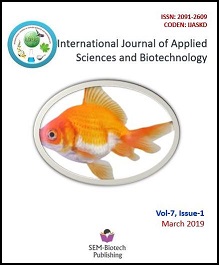Management of Obstructive Urolithiasis in a Male Buffalo Calf Using Tube Cystostomy Technique
DOI:
https://doi.org/10.3126/ijasbt.v7i1.22781Abstract
A 3-month-old male Murrah crossbred buffalo calf was presented to Veterinary Teaching Hospital (VTH), Rampur, Chitwan with a history of anuria for the past 4 days. Physical examination was carried out to check the status of the urethra and urinary bladder. Ultrasonography revealed an intact distended bladder. Based on the history of anuria and above examinations, the condition was diagnosed as obstructive urolithiasis. Meloxicam (0.3 mg/kg) was injected intramuscularly as a preemptive analgesia and Streptomycin Sulphate (10 mg/kg) was administered intramusculary as a prophylactic antibiotic. The calf was sedated with Xylazine-HCl (0.2 mg/Kg) and analgesia was achieved with epidural administration of Lignocaine-HCl (3 ml) at lumbosacral space (L6-S1). The left ventral paramedian site was aseptically prepared and laparotomy surgery was performed. The subcutaneous tunnel was made to pass the leading edge of the catheter and outlet is affixed with skin by placing stay suture on the ventral aspect of the abdomen. The urinary bladder is identified, isolated and decompressed by aspirating with 60-CC syringe and the 3-way Folley catheter was introduced on the dorsal aspect of the urinary bladder. Peritoneum was sutured with Catgut # 2-0 in continuous suture pattern and all the muscle layers were sutured together with Catgut # 2 using modified ford lock sutures. Subcutaneous tissue was sutured with Catgut # 1 in continuous suture pattern and skin was sutured using nylon # 1 in simple interrupted pattern. The calf was placed in sternal recumbency till it gets recovered from the anesthesia. The urinary acidifier ammonium chloride (13g) twice a day daily orally upto 30 days was prescribed. The same antibiotic was administered once a day daily for 5 days and the wound was dressed daily with povidone iodine till complete healing of the wound. Finally, the skin suture was removed after 14 days.
Int. J. Appl. Sci. Biotechnol. Vol 7(1): 120-123




